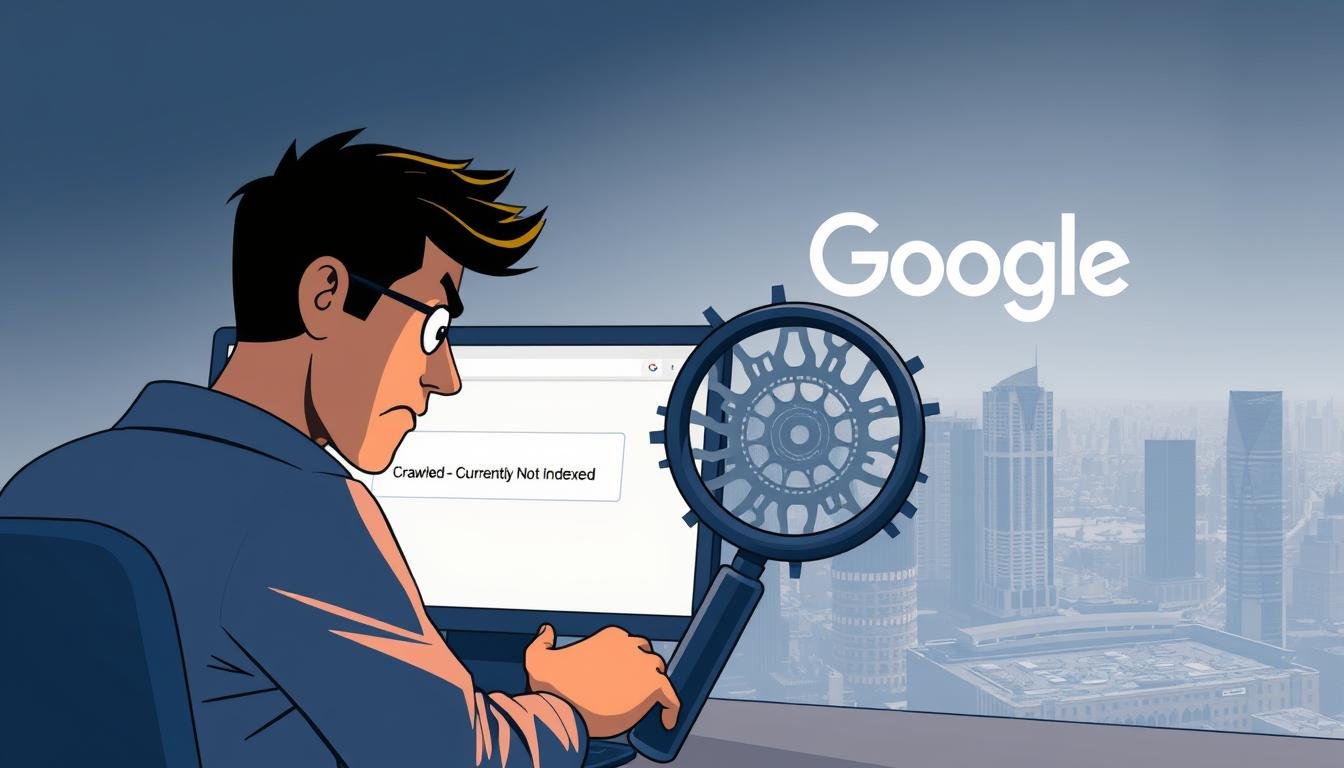Physical Address
304 North Cardinal St.
Dorchester Center, MA 02124
Physical Address
304 North Cardinal St.
Dorchester Center, MA 02124

Ever wondered why your website isn’t showing up in Google search results? It’s a common problem for webmasters. It can be really frustrating.
The issue often stems from the indexing process. If Google can’t index your site, it won’t show up for visitors. Seeing “Crawled – Currently Not Indexed” can be confusing. You might wonder what went wrong and how to fix it.
In this article, I’ll show you how to solve indexing problems. We’ll look at common issues that stop websites from being indexed. Then, we’ll share ways to get your site noticed by Google.
To get your website noticed, you need to know about Google’s indexing process. Google indexing is how Google finds, crawls, and adds web pages to its huge database, called the index. This database is used to show search results.
Crawling and indexing are two different steps. Crawling is when Google finds new and updated content. Indexing is when Google adds this content to its database. Not all crawled pages are indexed; they must be seen as useful by Google’s algorithms.

Google explains, “Indexing is the process of analyzing, storing, and understanding web page content.” This shows how important it is to have good, relevant content on your site.
Being indexed by Google is key for your site’s success. When your site is indexed, it can show up in search results. This brings organic traffic to your pages. A study found that “over 90% of web pages get zero organic traffic from Google,” showing the need for proper indexing.
“The key to getting your site indexed is to make it crawlable and ensure it has high-quality content.”
This highlights the need for both good technical SEO and quality content.
By understanding and optimizing for Google indexing, you can boost your website’s online presence. This will drive more traffic to your site.
Google indexing can face several common issues. These problems can make a website hard to find. Knowing what these issues are is the first step to fixing them.
The “Crawled – Currently Not Indexed” status shows Google has visited your page but hasn’t indexed it. It doesn’t always mean there’s a problem. Sometimes, Google just hasn’t decided to index the page yet.
Reasons for this status include low-quality content, duplicate content, or technical SEO issues. To fix it, you need to find and solve the root cause.
There are other indexing status problems too. Knowing about these can help you find and fix issues with your website.
This status means Google knows about your page but hasn’t crawled or indexed it. Make sure your page is easy for Google to crawl and has good content to solve this.
If a page is indexed but not in a sitemap, it means Google found and indexed it on its own. While it’s not a big problem, keeping your sitemap updated helps Google understand your site better.
To see if your site is indexed, use Google Search Console. Here’s how:
You can also use the Google search operator “site:” followed by your domain to see indexed pages.
| Indexing Status | Description | Action Required |
|---|---|---|
| Crawled – Currently Not Indexed | Google has crawled the page but not indexed it. | Improve content quality, fix technical SEO issues. |
| Discovered – Currently Not Indexed | Google is aware of the page but hasn’t crawled or indexed it. | Ensure the page is crawlable and contains high-quality content. |
| Indexed, Not Submitted in Sitemap | Google indexed the page organically. | Ensure your sitemap is up-to-date. |
To get your website indexed by Google, you must meet certain requirements. Your site needs to be open and set up right.
Google can only index your site if it’s open to search engines. You must remove any blocks that stop crawling and indexing.
Noindex tags tell search engines not to index certain pages. It’s important to remove these tags from key pages.
Your server should answer correctly to requests. A 200 status code means the page is accessible.
Google Search Console is key for getting your site indexed. Setting it up right is crucial for effective indexing.
Verifying your site’s ownership in Google Search Console builds trust. It also ensures you control your site’s indexing.
A sitemap helps Google understand your site’s layout. Submitting it through Google Search Console helps index your site.

| Prerequisite | Description | Importance |
|---|---|---|
| Removing Noindex Tags | Ensure important pages are not blocked from indexing | High |
| Checking Server Response Codes | Verify that your server responds with a 200 status code | High |
| Verifying Ownership in Google Search Console | Confirm your site’s ownership to ensure control over indexing | High |
| Submitting Your Sitemap | Help Google understand your site’s structure | High |
If your site shows “Crawled – Currently Not Indexed,” there are ways to fix it. Google might not index your page for many reasons. These include low-quality content, technical SEO problems, or bad internal linking. Here are seven methods to help solve these issues.
One easy way to get Google to index your site is through Google Search Console. This tool lets you tell Google about new or updated content. This can help your site get indexed faster.
Google loves high-quality, unique content. Make sure your content is well-researched, engaging, and valuable. Avoid duplicate or thin content, as it can hurt your Google index status.
Technical SEO problems can stop Google from crawling and indexing your site. Check for broken links, slow loading speeds, and wrong meta tags. Regular audits can find and fix these issues, helping your site get indexed.
A good internal linking strategy helps Google understand your site. Make sure to link to key pages from relevant content. This improves crawlability and indexing.
Getting high-quality backlinks from trusted sites can boost your site’s authority. Focus on creating linkable assets and getting relevant backlinks through outreach.

Google looks at user experience when deciding to index a page. Make sure your content is mobile-friendly, easy to navigate, and provides a good user experience. This can help your site’s Google index status.
Lastly, keep an eye on your site’s indexing status with Google Search Console. Adjust your strategies as needed. Track your site’s performance and make changes to improve indexing. This ensures your site stays crawled and indexed.
Fixing indexing problems often requires technical tweaks. To get Google to index your site well, you can use several advanced strategies.
The robots.txt file is key in controlling search engine crawling. It’s important to set it up right to avoid indexing problems. You can use it to tell search engines which pages to crawl and which to skip.
Best Practices:
XML sitemaps help search engines understand your site’s layout and content. By creating and submitting an XML sitemap, you can make indexing easier.
Tips for Effective XML Sitemaps:
Canonical tags are crucial for avoiding duplicate content problems. They help search engines understand which page is the original. This makes your content easier to index.
| Page Type | Canonical Tag Usage |
|---|---|
| Original Content | Self-referencing canonical tag. |
| Duplicate Content | Canonical tag pointing to the original content. |
Crawl budget is the number of pages Google crawls in a set time. Improving your crawl budget can help with indexing.
Pages with little value can use up your crawl budget. Find and reduce these pages to help Google focus on important content.
Make sure your most valuable content is easy to find and link to. This helps Google prioritize crawling your site.
To get Google to index your site, focus on creating high-quality, unique, and fresh content. This content should be relevant and valuable to your readers.
Creating unique content is key to getting indexed by Google. Your content should be informative, engaging, and valuable to your readers. Unique content sets your site apart from others. It’s important to do thorough research and use credible sources for your content.
Keeping your content fresh is crucial for indexing. Regular updates show Google that your site is active. I recommend updating your content at least once every few months. For blogs or news sections, update more often.
It’s not necessary to change everything. Even small updates or additions can help.
It’s important to avoid duplicate and thin content. Duplicate content can confuse Google and reduce your site’s visibility. Thin content lacks the substance Google looks for. Make sure each page has substantial and original content.
If you have multiple pages with similar content, consider consolidating them. Or make sure each page has a unique angle or focus.
| Content Strategy | Benefits for Indexing |
|---|---|
| Creating High-Value Content | Increases the likelihood of being indexed due to its uniqueness and relevance. |
| Regular Updates | Signals to Google that your site is active, promoting more frequent crawling and indexing. |
| Avoiding Duplicate Content | Prevents confusion for Google, ensuring that your original content gets indexed. |
Different websites have unique needs for Google indexing. It’s important to understand these needs to ensure your site is crawled and indexed properly. We’ll look at the specific needs for new websites, e-commerce sites, and mobile-friendly sites.
Getting indexed by Google can be tough for new websites. Make sure your site is technically sound and has a clear structure. Use header tags properly. Submitting your site to Google Search Console and creating a sitemap can help.
Also, start with high-quality, unique content. This tells Google your site is worth indexing.
E-commerce sites have many product pages, making indexing harder. Make sure each product page has unique descriptions and relevant keywords. Use a clear categorization structure and internal linking.
Regularly update product pages and make sure they are mobile-friendly. This will help with indexing.
Most searches are now on mobile devices. Google indexes mobile sites first. Make sure your mobile site is responsive and loads quickly.
Understanding your website type’s unique needs and implementing the right strategies can improve indexing. Whether it’s a new site, an e-commerce platform, or a mobile-friendly site, these tips will help you with Google indexing.
To make sure your site is indexed right, you need to watch its status closely. It’s important to keep an eye on your website’s indexing status. This helps you find and fix problems like ‘Crawled – Currently Not Indexed’.
Google Search Console (GSC) is a great tool for seeing how Google indexes your site. It gives you detailed reports on index coverage. These reports help you spot indexing problems.
The Index Coverage report in GSC shows how many pages are indexed and how many aren’t. It breaks down pages into different statuses. Knowing these statuses helps you fix indexing issues.
Valid pages are indexed correctly. Valid with warnings pages are indexed but have issues. Excluded pages aren’t indexed for reasons like canonicalization or crawling problems. Error pages have big issues that stop them from being indexed.
It’s crucial to check your site’s indexing status regularly in GSC. You can set up GSC to email you about big changes in your site’s indexing status.
Regular checks help you:
There are also third-party tools to help track indexation. Tools like Ahrefs, SEMrush, and Moz do SEO audits that include index tracking.
These tools offer extra insights, such as:
| Tool | Index Tracking Features |
|---|---|
| Ahrefs | Detailed index tracking, historical data, and competitor analysis |
| SEMrush | Comprehensive site audits, index tracking, and technical SEO recommendations |
| Moz | Index tracking, crawl diagnostics, and content optimization recommendations |
Using these tools with GSC gives you a better view of your site’s indexing status.
Getting your website indexed on Google is key to being seen online. To get Google to index my site, you need to know the process and common problems. Issues like “crawled – currently not indexed” can happen. But, by following the steps in this article, you can fix these problems and get your site indexed.
To keep your site indexed, check its performance often. Use Google Search Console and other tools for this. This way, you can spot and fix problems early. Creating great content and improving your site’s SEO can also help you stay indexed on Google.
By using these strategies, you can index your website on Google and keep a strong online presence. Stay active in keeping your site indexed. This ensures you stay visible in Google’s search results. Avoid problems like “crawled currently not indexed,” and use the Google index to bring more visitors to your site.